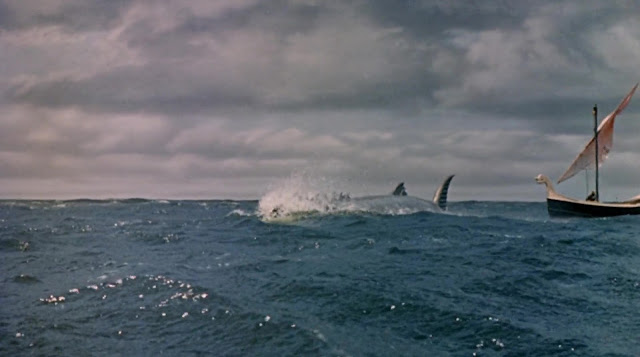The fish monster styled submersible was very effective as it silently surfaces in the distance behind the protagonist's boat on the process screen. The model was made from fibreglass on a metal frame. The miniature waves are really well done with a convincing scale and wind whipped crests. According to the excellent book The Wizard of MGM Memoirs of A. Arnold Gillespie a cut down war surplus Douglas Dauntless Dive Bomber fuselage was employed as a wind machine.
 |
| Joe Regan the wind and waves specialist in the MGM Lot 3 tank. The Dauntless wind machine can be seen to the left side of the sky backing with a 4 bladed propeller. |
Some of the ship models from the 1959 production of Ben Hur can also be seen floating in the harbour.
While the miniature work is very well staged, the optical effects of the crystal heat ray and some of the matte painting work seems a little below par.
 |
| The hero Demetrius has a dream involving this giant denizen of the deep. |
 |
| A particularly unconvincing matte painting. |
 |
| I feel this is a shot from another film with the triangular pit added as a matte painting. |
 |
| Here the triangular pit is the full size set with matte painted surrounding ground. |
 |
| Here again is a background from a previous film with the heat ray device and possibly some of the statuary added on top. |
 |
| The volcano is painted on the backing. |
 |
| Here it is a miniature close up cone section |
 |
| Not sure what happened here but there is a green and magenta colour shift where the collapsing rock is falling. |
 |
| I have seen these lava shots before in another film. |
 |
| Miniature burning building collapse possibly from Quo Vadis. |
 |
| An example of the crude heat ray optical effect. |
 |
| The heat ray matte doesn't fit too well as it was probably traced from one frame in the sequence and doesn't articulate to follow the movement in the shot. |
 |
| Quo Vadis burning Rome stock footage. |
 |
| You can see the split and little brass catch used to hold the skull cap in place on this teaching aid skeleton. |
 |
| The Ben Hur ship miniatures can be seen here. |
Source: The Wizard of MGM Memoirs of A. Arnold Gillespie Art director / Head of Special Effects from 1924-1965, Edited by Philip J. Riley & Robert A. Welch, Published by BearManor Media.
























































































































